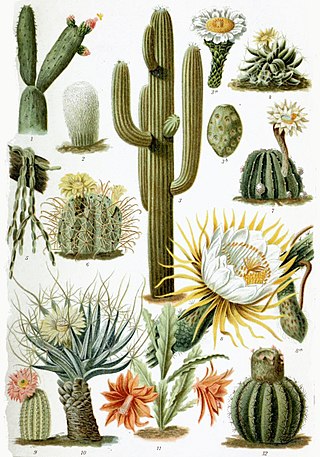
A cactus is a member of the plant family Cactaceae, a family of the order Caryophyllales comprising about 127 genera with some 1,750 known species. The word cactus derives, through Latin, from the Ancient Greek word κάκτος (káktos), a name originally used by Theophrastus for a spiny plant whose identity is now not certain. Cacti occur in a wide range of shapes and sizes. They are native to the Americas, ranging from Patagonia in the south to parts of western Canada in the north, with the exception of Rhipsalis baccifera, which is also found in Africa and Sri Lanka. Cacti are adapted to live in very dry environments, including the Atacama Desert, one of the driest places on Earth. Because of this, cacti show many adaptations to conserve water. For example, almost all cacti are succulents, meaning they have thickened, fleshy parts adapted to store water. Unlike many other succulents, the stem is the only part of most cacti where this vital process takes place. Most species of cacti have lost true leaves, retaining only spines, which are highly modified leaves. As well as defending against herbivores, spines help prevent water loss by reducing air flow close to the cactus and providing some shade. In the absence of true leaves, cacti's enlarged stems carry out photosynthesis.
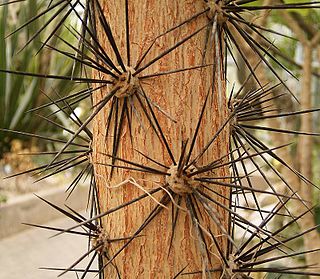
In botany, areoles are small light- to dark-colored bumps on cacti out of which grow clusters of spines. Areoles are important diagnostic features of cacti, and identify them as a family distinct from other succulent plants. The spines are not easily detachable, but on certain cacti, members of the subfamily Opuntioideae, smaller, detachable bristles, glochids, also grow out of the areoles and afford additional protection.

Pereskia is a small genus of about four species of cacti that do not look much like other types of cacti, having substantial leaves and non-succulent stems. The genus is named after Nicolas-Claude Fabri de Peiresc, a 16th-century French botanist. The genus was more widely circumscribed until molecular phylogenetic studies showed that it was paraphyletic. The majority of species have since been transferred to Leuenbergeria and Rhodocactus. Although Pereskia does not resemble other cacti in its overall morphology, close examination shows spines developing from areoles, and the distinctive floral cup of the cactus family.
The common name leaf cactus refers to any of the following genera in the family Cactaceae:

In 1984, the International Organization for Succulent Plant Study set up a working party, now called the International Cactaceae Systematics Group, to produce a consensus classification of the cactus family, down to the level of genus. Their classification has been used as the basis for systems published since the mid-1990s. Treatments in the 21st century have generally divided the family into around 125–130 genera and 1,400–1,500 species, which are then arranged in a number of tribes and subfamilies. However, subsequent molecular phylogenetic studies have shown that a very high proportion of the higher taxa are not monophyletic, i.e. they do not contain all of the descendants of a common ancestor. As of August 2023, the internal classification of the family Cactaceae remained uncertain and subject to change. A classification incorporating many of the insights from the molecular studies was produced by Nyffeler and Eggli in 2010.
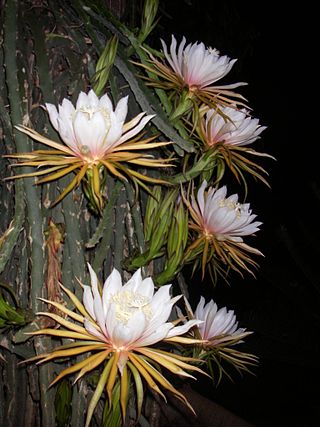
Hylocereus is a former genus of epiphytic cacti, often referred to as night-blooming cactus. Several species previously placed in the genus have large edible fruits, which are known as pitayas, pitahayas or dragonfruits. In 2017, a molecular phylogenetic study confirmed an earlier finding that the genus Hylocereus was nested within Selenicereus, so all the species of Hylocereus were transferred to Selenicereus.

Cylindropuntia is a genus of cacti, containing species commonly known as chollas, native to northern Mexico and the Southwestern United States. They are known for their barbed spines that tenaciously attach to skin, fur, and clothing. Stands of cholla are called cholla gardens. Individuals within these colonies often exhibit the same DNA, as they were formerly tubercles of an original plant.

Grusonia is a genus of opuntioid cacti, originating from the North American Deserts in Southwest United States and northern Mexico, including Baja California. Authors differ on precise boundaries of the genus, which has been included in Cylindropuntia. Corynopuntia, also known as club chollas, is now a synonym, with the genus originally being described by Knuth in 1935. Molecular phylogenetic studies suggest that it should be included in Grusonia, a view accepted by Plants of the World Online as of June 2021.

Quiabentia is a genus of cacti, closely related to Pereskiopsis.
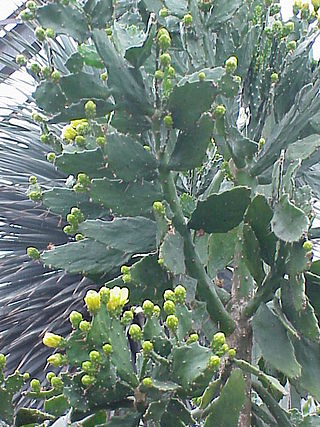
Brasiliopuntia is a genus in the cactus family, Cactaceae. It contains only one species, Brasiliopuntia brasiliensis.
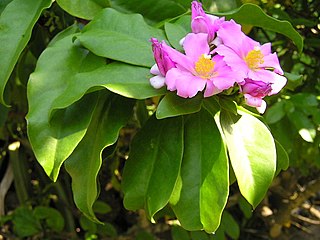
Rhodocactus is a genus of flowering plant in the cactus family Cactaceae, native to central South America. Unlike most species of cacti, Rhodocactus has persistent leaves and a fully tree-like habit. The genus was sunk into a broadly circumscribed Pereskia, but molecular phylogenetic studies from 2005 onwards showed that with this circumscription Pereskia was paraphyletic, and in 2016, Rhodocactus was restored for southern South American species.

Opuntioideae is a subfamily of the cactus family, Cactaceae. It contains 15 genera divided into five tribes. The subfamily encompasses roughly 220–250 species, and is geographically distributed throughout the New World from Canada, to Argentina. Members of this subfamily have diverse habits, including small geophytes, hemispherical cushions, shrubs, trees, and columnar cacti consisting of indeterminate branches or determinate terete or spherical segments.

Rhodocactus grandifolius is a species of cactus native to eastern and southern Brazil. Like all species in the genus Rhodocactus and unlike most cacti, it has persistent leaves. It was first described in 1819. It is grown as an ornamental plant and has naturalized outside its native range.

Rhodocactus bahiensis is a species of tree-like cactus that is endemic to the Brazilian state of Bahia. First described as Pereskia bahiensis, it was transferred to Rhodocactus in 2016. Like all species in the genus Rhodocactus, and unlike most cacti, it has persistent leaves. In its native locality, it is used to form hedges.

Rhodocactus stenanthus is a species of cactus that is endemic to Brazil. First described as Pereskia stenantha, it was transferred to Rhodocactus in 2016. Like all species in the genus Rhodocactus, and unlike most cacti, it has persistent leaves. In its native locality, it is sometimes used in hedges.

Pereskiopsis diguetii, synonym Pereskiopsis spathulata, is a species of cactus in the subfamily Opuntioideae.

The Rhipsalideae are a small tribe of cacti, comprising four or five genera. They grow on trees (epiphytes) or on rocks (lithophytes), where they either hang down or form creeping or upright shrubs. Their flowers open in the day and remain open at night; they may be either radially symmetrical (regular) or bilaterally symmetrical (zygomorphic). The fruits are berry-like, fleshy with smallish seeds.

Leuenbergeria is a genus of flowering plant in the family Cactaceae, mostly native around the Caribbean. Unlike most cacti, it has persistent leaves and develops bark on its stems early in its growth. The genus was created in 2012 by Joël Lodé. Before the creation of Leuenbergeria as a genus, the species within it were included in a broadly circumscribed genus, Pereskia. Leuenbergeria is the only genus in the subfamily Leuenbergerioideae.
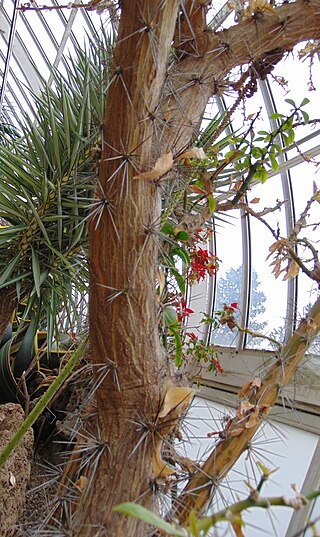
Rhodocactus nemorosus is a species of flowering plant in the cactus family Cactaceae, native to southern Brazil, Paraguay, Uruguay and northeast Argentina. Like all species in the genus Rhodocactus and unlike most cacti, it has persistent leaves. It was first described by Nicolás Rojas Acosta in 1897 as Pereskia nemorosa, and transferred to Rhodocactus in 2016.

Rhodocactus sacharosa, synonym Pereskia sacharosa, is a species of flowering plant in the cactus family Cactaceae, native from Bolivia and west-central Brazil to Paraguay and northern Argentina. Like all species in the genus Rhodocactus and unlike most cacti, it has persistent leaves. It was first described in 1879.






















